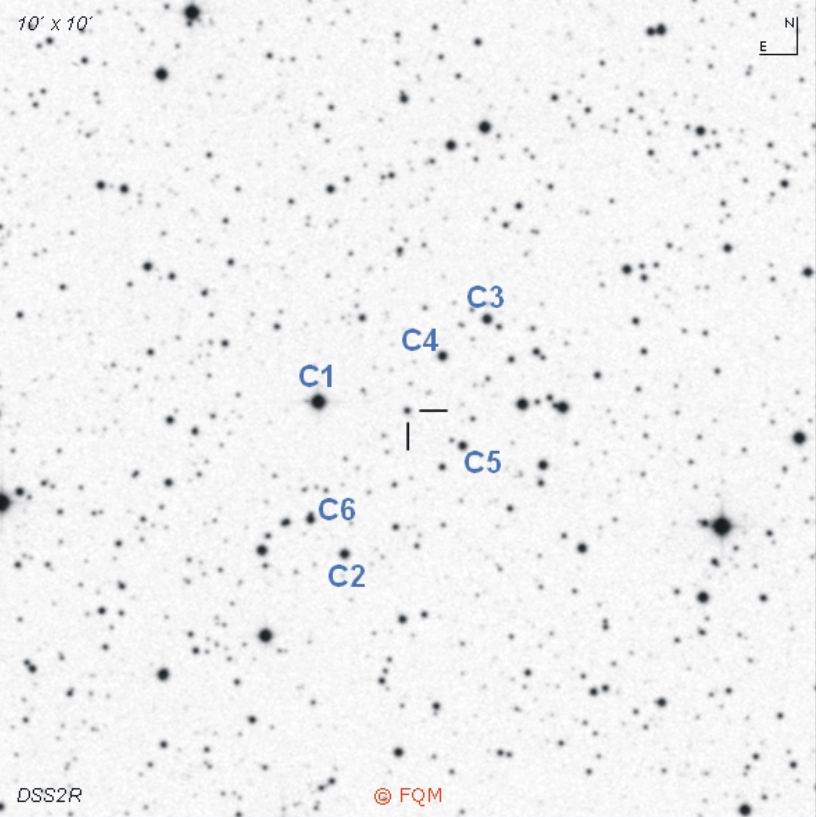
| Frankfurt Quasar Monitoring |
| PKS 1749+096 (OT 081) |
| Cross-Identifications |
OT+081, PKS 1749+096, 1749+096, S5 1749+096 4C +09.57, 4C 09.57, RX J1751.5+0938, LEDA 84878 1AXG J175132+0939, S3 1749+09, TXS 1749+096 QSO B1749+096, INTREF 862, 2E 1749.1+0939 87GB 174910.4+093921, 1FGL J1751.5+0937 |
| Equat. coordinates | RA 17 51 32.8 DE +09 39 02 (J2000) |
| Constellation | Ophiuchus |
| Type |
QSO |
|
Redshift |
z=0.322 |
|
Distance (2) (3) |
1230 Mpc |
| Total mag range (mv) (4) (5) | 14.1 - 18.4 |
| Catalog Magnitude (1) | 16.78 |
| Absolute Magnitude (1) | -24.1 MB |
| Light Travel-Time (2) | 3.491 × 109 yrs |

Comparison stars
| star | V | Rc | Ic |
| C1 | 11.95
(0.04) |
11.45
(0.04) |
11.00
(0.03) |
| C2 | 14.17
(0.04) |
13.75
(0.04) |
13.38
(0.04) |
| C3 | 14.23
(0.04) |
13.80
(0.04) |
13.39
(0.04) |
| C4 | 14.36
(0.04) |
13.94
(0.04) |
13.55
(0.04) |
| C5 | 14.89
(0.04) |
14.45
(0.04) |
14.02
(0.04) |
| C6 | 14.91
(0.05) |
14.32
(0.05) |
13.88
(0.04) |
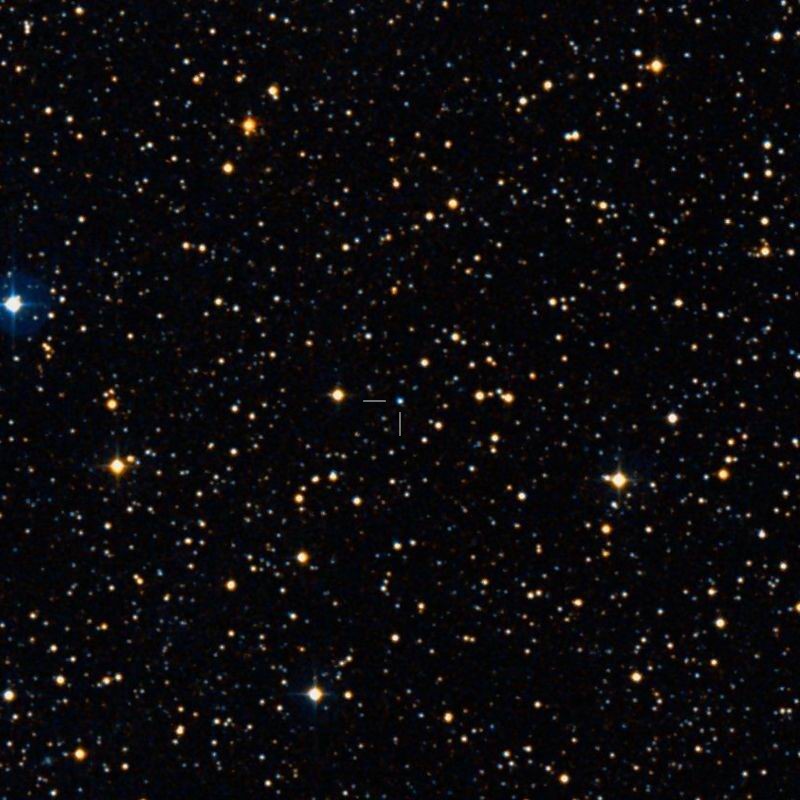
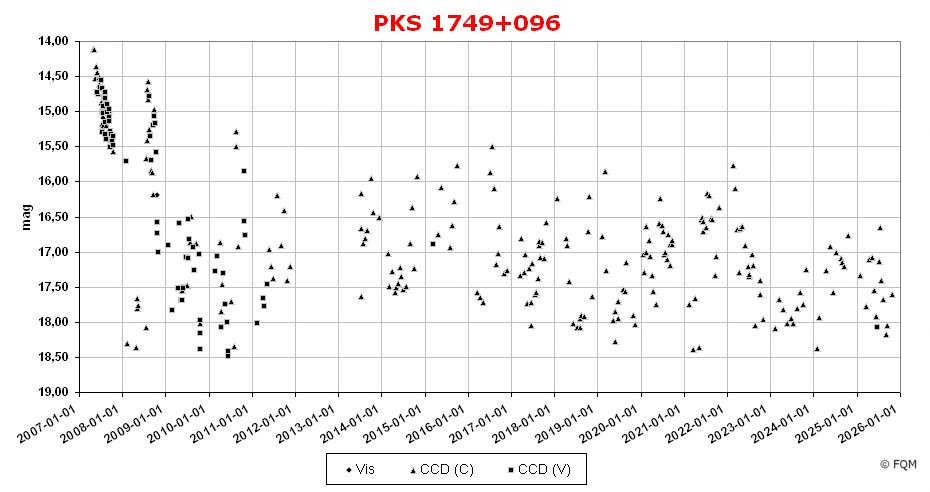
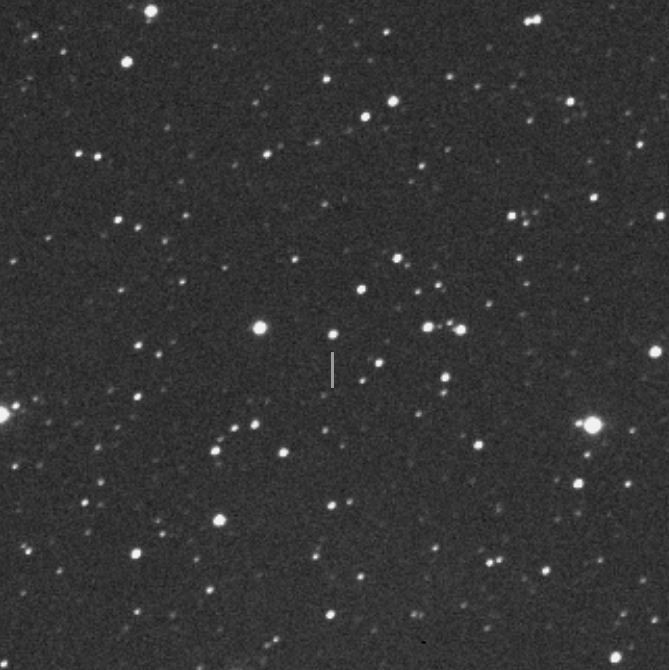 25-Apr-2007,
14.12C, 60cm-CGT f/3.3 [Size 10´× 10´]
|
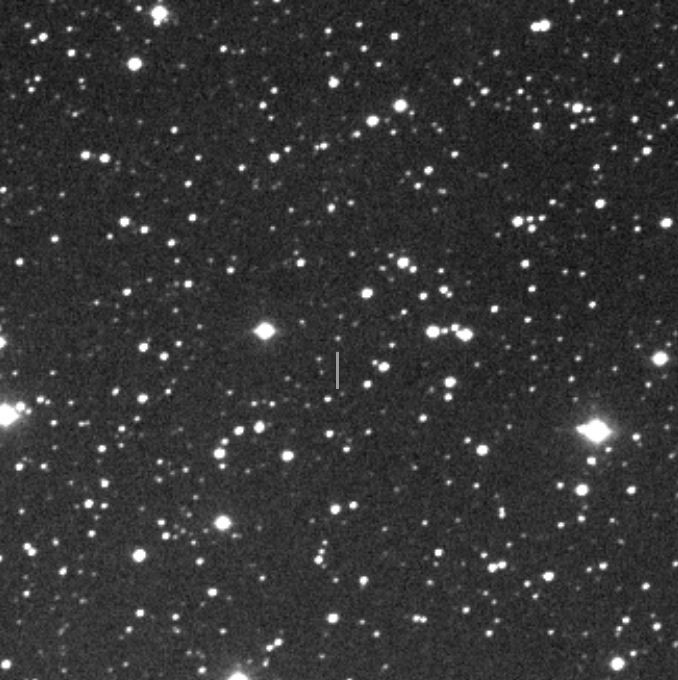 |
| PKS
1749+096 =
OT 081 is a violently variable quasar in northern Ophiuchus. It was
discovered as a radio source around 1967 during the radio survey
of the 4th Cambridge Survey of Radio Sources (4C) and the Ohio State
University
Radio Survey (OT). The optical counterpart was found in 1973 as a
stellar object of
approximately 18 mag. Wills et al. (1976) reported R=17 mag, estimated
from the red
plate of the POSS-Survey. 1749+096 is a well-known radio source, and as
such, it was catalogued by various other radio surveys (OT, PKS, 4C, S5).
Emissions of X-rays (RX, 2E) and even gamma-rays (INTREF) were detected
later. Initial spectroscopy showed a continuous spectrum. This,
together with
its optical polarization, led to the object being classified as a BL
Lacertae
object. During faint state in June 1987, weak emission lines were
detected.
As a result,
Stickel et al. (1988) reported a redshift of z=0.320,
independently confirmed by White et al. (1988), who reported z=0.322. A
redshift of z=0.322 means that the light we receive today started its
journey through space about 3.5×109 years
ago. Professional high resolution photographs showed that the optical stellar image "is resolved with a nearly circular symmetric nebulosity surrounding the central point source" (Stickel 1988). The host galaxy of 1749+096 was discovered. Today, the host galaxy is catalogued with the designation LEDA 84879 in the HyperLEDA Catalogue. After detecting emission lines in the spectra, 1749+096 was classified as a weak lined quasar. Today, both classifications, Quasar and BL Lac object, are valid. In the quasar catalogues published by Véron-Cetty et al. (2001-2006), 1749+096 was classified as a quasar. Quasar 1749+096 = OT 081 is a violently variable object. Prior to 2007, a total range of about 2.7 mag was reported, ranging between about 16 mag and mid 18 mag - resting around the fainter end for most of the time. In April 2007, a major outburst occurred (see light curve above). During Frankfurt Quasar Monitoring project, a peak brightness of mag 14.12 was recorded on the 25th April, 2007. This was about 2 magnitudes brighter than earlier maximum stages of 1749+096. The outburst was followed by a long lasting highly active phase until autumn 2007. The next optical outburst was detected in July 2008 with a maximum brightness of mag 14.57. In 2009 and 2010, the violently up and down continued, with another narrow peak-like outburst in August 2010. Usually, outbursts show up as peak-like events: short duration characterized by a steep increase and then decline in brightness. But this was not the case for 1749+096. The major outburst in April 2007 was of extraordinarily long duration. Furthermore, it was the brightest optical outburst of 1749+096 ever detected. So the total optical variability increased to about 4 magnitudes ranging from 14.1 to 18.4 mag. CCD observers, as well as visual observers, shall use the comparison stars given above. Other photometric sequences were published by Craine et al. (1975) and Smith et al. (1998). ____________
Quasar 1749+096 can be found in northern Ophiuchus, 5° SE of Alpha Ophiuchi and 5.4° NE of Beta Ophiuchi. The quasar field is located in the outskirts of the summer Milky Way, so there is a large number of interesting deep sky objects nearby. Three open clusters are worth observing with small aperture telescopes: IC 4665 (4° SSW), NGC 6633 (9.4° SE) and IC 4756 (12° SE). The bright face-on spiral galaxy NGC 6384 is only some 5.4° away to the SW. Another deep sky showpiece can be found some 5.8° to the SE: NGC 6572, a bright planetary nebula of extraordinary blue-green or greenish colour. Another bright extragalactic variable object can be found 6.8° WNW of quasar 1749+096. H 1722+119 is a variable 15-mag BL Lac object at a distance of approximately 1.9×109 light-years. |
| Browne, I.W.A., Crowther, J.H., Adgie, R.L. 1973, Nature, 244, 146; Some Identifications of Radio Sources with neutral stellar objects. Fitch, L.T., Dixon, R.S., Kraus, J.D., et al. 1969, AJ, 74, 612F; A high-sensitivity 1415-MHz survey between declinations of 0 and 20 north. Fiorucci, M., Tosti, G., Rizzi, N. 1998, PASP, 110, 105F; VRI Photometry of Stars in the Fields of 16 Blazars. Gower, J.F.R., Scott, P.F., Wills, D. 1967, MmRAS, 71, 49G; A survey of radio sources in the declination ranges -07 to 20 and 40 to 80. Hewitt, A., Burbidge, G. 1989; A New Optical Catalog of Quasi-Stellar Objects. Karge, S. 2007, The Astronomer, Vol. 44, No 520, 100; The exceptional 2007 Outburst of Quasar PKS 1749+096. Karge, S. 2008, VdS-Journal 27, 122; Quasar PKS 1749+096: Der außergewöhnlich starke Ausbruch des Jahres 2007. Paturel, G., Petit, C., Prugniel, P., et al. 2003, A&Ap, 412, 45; HYPERLEDA. I. Identification and designation of galaxies. Pica, A.J., Smith, A.G., Webb, J.R., et al. 1988, AJ, 96, 1215; Long-term optical behavior of 144 compact extragalactic objects - 1969-1988. Stickel, M., Fried, J.W., Kühr, H. 1988, A&A, 191, L16; The redshifts of the BL Lac objects 1749+096 and 2254+074. Stickel, M., Fried, J.W., Kühr, H. 1993, A&AS, 98, 393; The complete sample of 1 Jy BL Lac objects. II - Observational data. Strittmatter, P.A., Carswell, R.F., Gilbert, G., Burbidge, E.M. 1974, ApJ, 190, 509; Spectroscopic observations of objects identified with radio sources. Véron-Cetty, M.-P., Véron, P. 2001, A&A 374, 92; A Catalogue of Quasars and Active Nuclei: 10th edition. Véron-Cetty, M.-P., Véron, P. 2003, A&A 412, 399; A Catalogue of Quasars and Active Nuclei: 11th edition. Véron-Cetty, M.-P., Véron, P. 2006, A&A 455, 776; A Catalogue of Quasars and Active Nuclei: 12th edition. Véron-Cetty, M.-P., Véron, P. 2010, A&A 518, 10; A Catalogue of Quasars and Active Nuclei: 13th edition. White, G.L., Jauncey, D.L., Wright, A.E., et al. 1988, ApJ, 327, 561W; Redshifts of southern radio sources. VII. Wills, D., Wills, B.J. 1976, ApJS, 31, 143; Spectroscopy of 206 QSO candidates and radio galaxies. Wurtz, R., Stocke, J.T., Yee, H.K.C. 1996, ApJS, 103, 109W; The Canada-France-Hawaii Telescope Imaging Survey of BL Lacertae Objects. I. |
| Links: Landessternwarte Heidelberg AAVSO [vsnet-alert 9356] Blazar PKS 1749+096 in outburst THE ASTRONOMER Electronic Circular No 2471 |
| home |